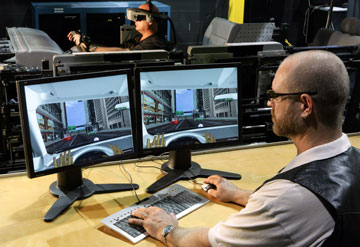
DEARBORN, MI – Ford Motor Co. has found a way to settle the ages-old battle between engineers and designers: with one foot in the real world and the other in cyberspace.
In what the auto maker claims is an industry-first, Ford has married reconfigurable models with virtual data to simulate, in real time, attributes such as driver comfort. Application of this technology shaved at least six months from the development of the ‘09 Ford Flex cross/utility vehicle, the auto maker says.
Patrick Schiavone, design director-Ford North America truck and SUV, recalls a particularly nasty clash he had with an engineering colleague over the Flex’s beltline.
“I always want a higher belt line,” Schiavone says. But until Ford developed its Programmable Vehicle Model (PVM), there was no reliable means of determining optimum dimensions in a timely fashion.
Bucks were built, debates raged and the bucks were rebuilt, Schiavone says. Meanwhile the clock was always ticking.
Now, fights can be settled by getting behind the wheel of the PVM, which is configured to reflect a proposed set of dimensions for a vehicle in development. For full effect, designers and developers can don a set of goggles that transport the wearer into a virtual version of the finished vehicle as it would appear on the street.

As a result, decision-makers benefit from the look and feel of the vehicle as it would function in traffic, pedestrian and vehicular, and in all kinds of weather. The reconfigurable capability of the PVM negates any need to build a new physical property because changes to dimensions, such as as belt lines, can be made on the spot.
“All the stakeholders (are) able to stand around and see if it works,” Schiavone says.
Ford also integrates motion-capture technology, used in the film industry to ensure animated characters move naturally, to insert the tester into the vehicle environment.
Notably, the software used by Ford to simulate the vehicle and its environment can be adjusted to replicate the perspective of an occupant who is short or tall. This ensures vehicles are not built to suit only the product developers.
“A well-designed vehicle does not remind you of your age, that you’re too tall, too short, too small or too large,” says Eero Laansoo, Ford Flex human-factors engineer.
The auto maker says its investment in virtual tools can reduce product-development time by eight to 14 months.
Says Elizabeth Baron, virtual reality and advanced visualization technical specialist: “(Ford’s) lab gives us a compelling competitive advantage.”




